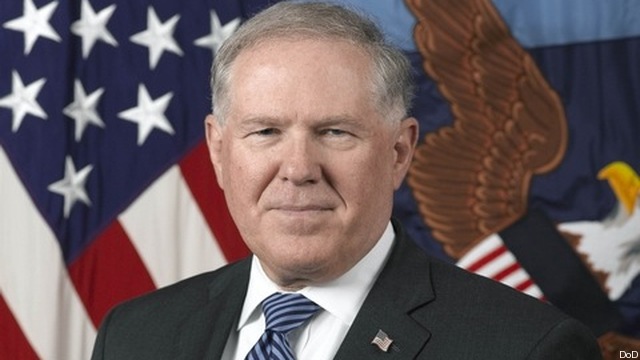CAPITOL HILL: The United States will begin serious development of prototypes for so-called sixth generation fighters — successors to the F-35 and F-22 — for the Navy and the Air Force in the 2016 budget, says the head of Pentagon acquisition, Frank Kendall.
The Aviation Innovation Initiative is a new effort, not an agglomeration of existing DARPA programs, Kendall told me during a vote break at today’s hearing. He declined to say how much money the new initiative is getting, only calling it “significant.” I would assume that means between $150 million and $500 million or so for the first few years, given the fact they are developing airframe and engine prototypes. Developing several bleeding edge prototypes — which is what a DARPA effort like this would presumably target — could not be done for peanuts.
The main goals of this effort — aside from developing and proving technologies — is to preserve the defense industry design teams that are crucial to building aircraft (and who don’t have much work right now) reduce lead times and reduce program risk, Kendall told us.
For those who follow this in detail, Kendall has pushed hard for DARPA to do work to keep the design teams going both for airframes and for engines. Air Force Chief of Staff Gen. Mark Welsh has also called for work to begin on a sixth generation fighter. The engine work has been known as AETD — Advanced Engine Technology Demonstrator. Kendall says that work “continues, not exactly as it was before, but it continues.”
The existing DARPA effort has been known as the Air Dominance Initiative. Eight DARPA program managers work with Air Force and Navy experts looking at networking and communications, control of the electromagnetic spectrum, sensors, what role space assets play and how manned and unmanned systems work together,
In acquisition news, Kendall told the HASC something that has the potential to really reshape the debate about weapons budgeting. He referred to a study of weapons cost growth. It found acquisition policy changes made no demonstrable difference.to costs. What did, you ask? Budgets, baby, budgets. When the money flowed, believe it or not, weapons cost less. When budgets were tight, cost growth soared, Kendall told the committee. When budgets were fat, cost growth average 10 percent. When budgets were tight, those costs ballooned to 30 percent.
“What this is telling me is that behaviors change when we have tight budgets,” Kendall told the HASC. Bureaucrats try to “hang on to things we really can’t afford.” and the defense industry is hungrier and pushes harder to keep revenue flowing.
“This,” dear reader, “has an impact far beyond anything else we are looking at,” according to the man who buys the Pentagon’s weapons. That’s right. Acquisition reform. Eh! Aggressive congressional oversight. Hmm. But regular cash flow — stable budgeting and, I would argue, program reserves — can make a serious difference.
The space and intelligence communities are very familiar with using program reserves to better manage their risk and avoid whiplashes in funding. While Congress is unlikely to be comfortable with the beefy reserves that get built into advanced intelligence acquisitions (often more than 25 percent of a year’s budget), increasing the reserves from their present paucity may be one way of providing more consistent and flexible funding.
Finally, Kendall offered a bit of detail about the aircraft carrier technology agreement India and America signed during President Obama’s visit. The deal included a wonderfully vague reference to sharing carrier technology so I asked Kendall about it during the vote break during today’s hearing.
First, he said he didn’t think he should share any details. Then he offered this: “India has aircraft carriers and they are interested. in some of the technology we are fielding. We are going to look at what we can possibly export,’ he said. I would bet that might include the Electromagnetic Aircraft Launch System (EMALS). An awful lot of the radar, other sensors, and command and control gear on the carrier would probably hit the arms export approval wall. But, given how close India and the US are getting, maybe I’m wrong.
In a ‘world first,’ DARPA project demonstrates AI dogfighting in real jet
“The potential for machine learning in aviation, whether military or civil, is enormous,” said Air Force Col. James Valpiani. “And these fundamental questions of how do we do it, how do we do it safely, how do we train them, are the questions that we are trying to get after.”



























